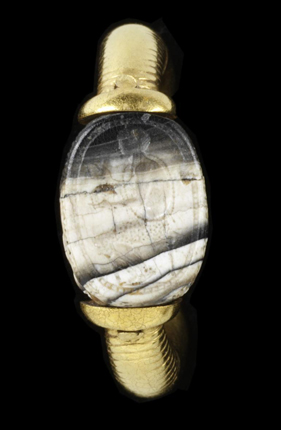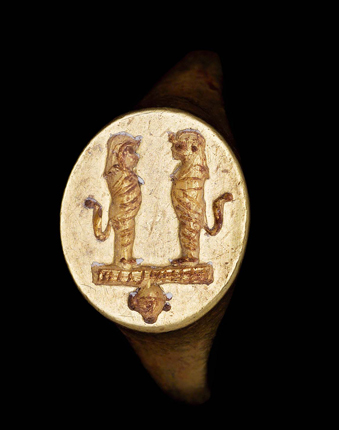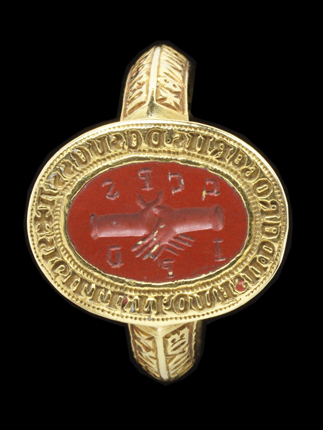“Shell Auranova” is the next generation of the brand’s bridal line, featuring half-bezel engagement rings with bold and fluid designs.
The History Behind … Signet Rings
Once used as seals and still embraced by today’s jewelry designers, signet rings have held an enduring allure throughout the ages.

New York--Signet rings are having a moment in jewelry design.

Or perhaps it’s more accurate to say that they’re having a millennium, though even that is an understatement; signet rings have been in existence since before the Bible.
For a little context on the ubiquitous style, National Jeweler spoke with Gross and historian Emily Stoehrer of the Museum of Fine Arts, Boston, as well as contemporary jewelry designers who are embracing the signet ring now.
How far back do signet rings date?
“In our collection alone,” Stoehrer said of the Museum of Fine Arts, Boston’s permanent archives, “we have (signet rings) that go back to ancient Mesopotamia, ancient Egypt and ancient Nubia.”

Gross said that signet rings were prevalent enough in human culture that they were mentioned in the Bible, “specifically The Book of Esther, which talks about Persian King Ahasuerus’s signet ring.”
“While the Bible may or may not be taken as entirely factual,” Gross continued, “the way people used and wore them traditionally is useful information that we can culturally rely on.”
What are the details of the ring’s origins; what was its function?
Signet rings were typically made entirely of gold or featured carved gemstones, or intaglios.
“They were really used as a signature

“Signet rings were used as seals,” Gross explained, “as a symbol or mark of the hand that sent or signed a document. Wax was melted onto the document and the top of the ring was impressed into the wax, leaving a clear and permanent mark. The top of the ring was usually set with a hardstone that had been deeply engraved with some kind of symbol or depiction.”
To denote the ring’s wearer, signets were comprised of “identifying marks” according to Stoehrer, like coats of arms, monograms, family seals or initials.
During which historical periods were signet rings most popular?
Signet rings were used from ancient times through the early 19th century, Gross said.
Yet even as more people became literate and the use of signet rings as document seals declined, the pieces maintained their popularity.

Gross explained, “During the late 19th century, (signet) rings became more of a status symbol, rather than a legal mark. The tops of the rings had decoration or engraving (and) often were gem set, or if they were metal intensive, they bore initials done in shallow-yet-decorative engraving. You could probably say that it was in the 19th century that signet rings became more of a personal statement.”
“In (the Museum of Fine Arts, Boston’s) collection of carved gems we have a lot of ancient carved gems that have been set in rings (from the Middle Ages). We see these gemstones being reused by subsequent generations to become more of a fashionable style rather than a signature.”
The Modern Interpretation
Today’s signet rings aren’t dissimilar to ancient styles. Many embrace the personalized aspect of signet rings, engraving them with customers’ monograms or the initials of their loved ones, a practice which “makes memories wearable,” according to Single Stone designers Ari and Corina Madilian.
Ariel Gordon has built her fine jewelry business on the nostalgic appeal of custom jewelry like engraved signet rings. She feels that personalization lends an importance to jewelry that goes beyond accessorizing.
“Most of the jewels in my personal uniform are custom engraved or set with birthstones for my loved ones,” said Gordon. “It feels more deliberate this way and less like I’m just piling things on for no reason. A signet ring is the pinnacle of personalized jewelry.”
Designer Elisa Solomon, who makes an oval-shaped signet ring in her signature organic, handmade style said, “I often inscribe (signet rings) with a bride’s married monogram or the first initial of a newborn’s name; I have also created pieces with specific birthstones. I love that they connect to a person’s individuality.”
Many designers noted the automatic heirloom status of a piece of jewelry that has been personalized to represent its wearer.
“My secret hope is that my customers view my designs as modern heirlooms to be passed down through generations, as so many of those seals were in the past,” said Delphine Leymarie, whose skull signet ring invokes the macabre mood of many historical designs.
Letters by Zoe designer Stephanie Hayoun said, “I personally possess my ancestors’ signet rings and love their simple and historic beauty and the tangible link it affords me to my family.”
The Next Incarnation
Foundrae designer Beth Bugdaycay constructed an entire range of fine jewelry around enamel-adorned signet rings with inscriptions and images that are talisman-like in their symbolism. “The cigar bands and signet rings were the very first pieces designed,” she said. “They embodied the idea of creating future heirlooms that capture at least a piece of (a woman’s) story and ideally help to inspire her next chapter.”
Designer Alison Chemla, of the brand Alison Lou, has done the most with signet rings in terms of modernizing the design and adapting the classic style to a uniquely 21st century point of view. Her playful, emoji-inspired offerings are at their wittiest in her hefty signet styles that feel as luxurious as they do clever.
“Playing with classic jewelry norms is something I do often in my designs,” said Chemla. “I love the history behind (signet rings) and the way that they look; however, instead of using my signet rings as a seal of identification, I’ve made them a seal of your personality.”
The Latest

Boucheron and Pomellato performed well in an otherwise bleak quarter for Kering amid struggles at Gucci.

Designer Deborah Meyers created her birds from oxidized sterling silver, rose-cut diamond eyes, and Akoya Keshi pearl feathers.

Six new retail businesses were selected for the 2025 program, which began in January.

The company said it expects sightholders to remain “cautious” with their purchasing due to all the unknowns around the U.S. tariffs.


Sponsored by the Gemological Institute of America

Simon Wolf shares why the time was right to open a new office here, what he looks for in a retail partner, and why he loves U.S. consumers.

The risk of laboratory-grown diamonds being falsely presented as natural diamonds presents a very significant danger to consumer trust.

A third-generation jeweler, Ginsberg worked at his family’s store, Ginsberg Jewelers, from 1948 until his retirement in 2019.

The company failed to file its quarterly reports in a timely manner.

The organization also announced its board of directors.


Located in Valenza, the now 355,000-square-foot facility includes a new jewelry school that’s open to the public, Scuola Bulgari.

Paola Sasplugas, co-founder of the Barcelona-based jewelry brand, received the Fine Jewelry Award.

A platinum Zenith-powered Daytona commissioned in the late ‘90s will headline Sotheby’s Important Watches sale in Geneva next month.

The basketball stars wear men’s jewelry from the “Curb Chain” collection.

The Signet Jewelers-owned retailer wants to encourage younger shoppers to wear fine jewelry every day, not just on special occasions.

The 21 pieces, all from a private collector, will be offered at its Magnificent Jewels auction next month.

Lilian Raji answers a question from a reader who is looking to grow her jewelry business but has a limited marketing budget.

GCAL by Sarine created the new role to sharpen the company’s focus on strategic partnerships and scalable expansion.

The Indiana jeweler has acquired Scottsdale Fine Jewelers in Scottsdale, Arizona.

“Cartier: Design, Craft, and Legacy” opened earlier this month at the Victoria and Albert Museum in London.

Van Cott Jewelers in Vestal, New York, is hosting a going-out-of-business sale.

Industry veteran Samantha Larson has held leadership roles at Borsheims, McTeigue & McClelland, Stuller, and Long’s Jewelers.
The two organizations will hold the educational event together this fall in Mississippi.

The entrepreneur and “Shark Tank” star will share his top tips for success.

The Ukrainian brand’s new pendant is modeled after a traditional paska, a pastry often baked for Easter in Eastern European cultures.

The jeweler has announced a grand reopening for its recently remodeled location in Peoria, Illinois.


























